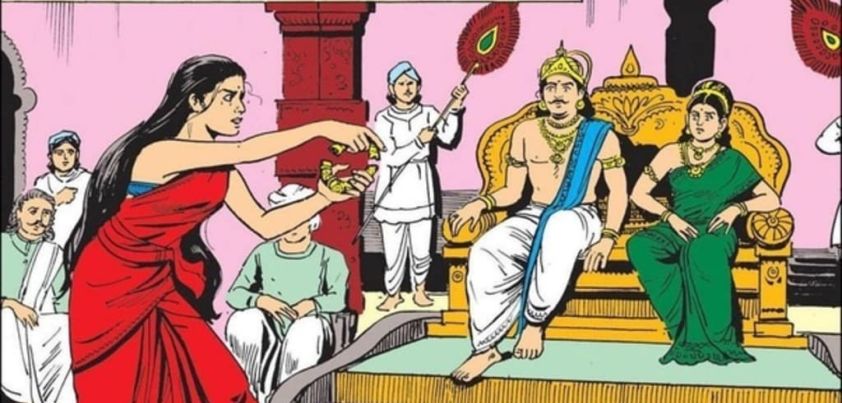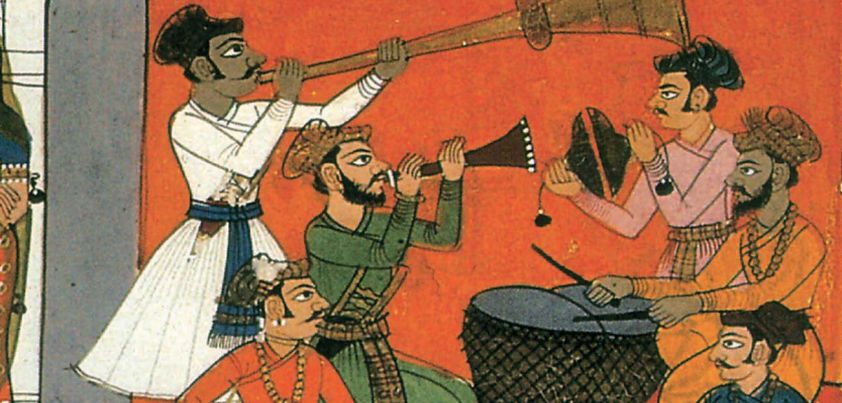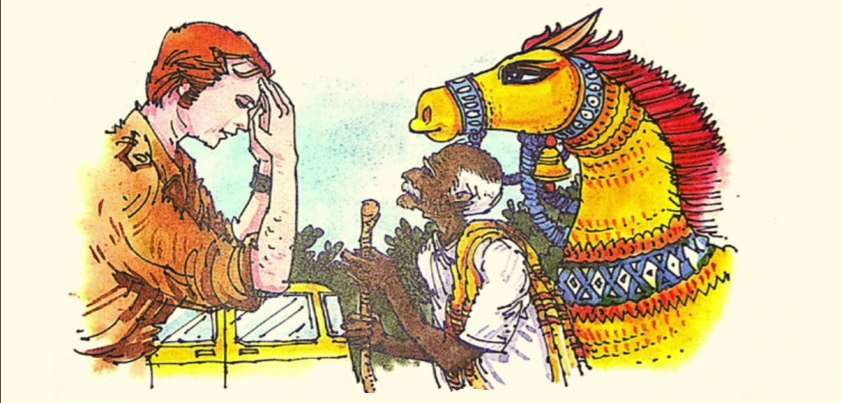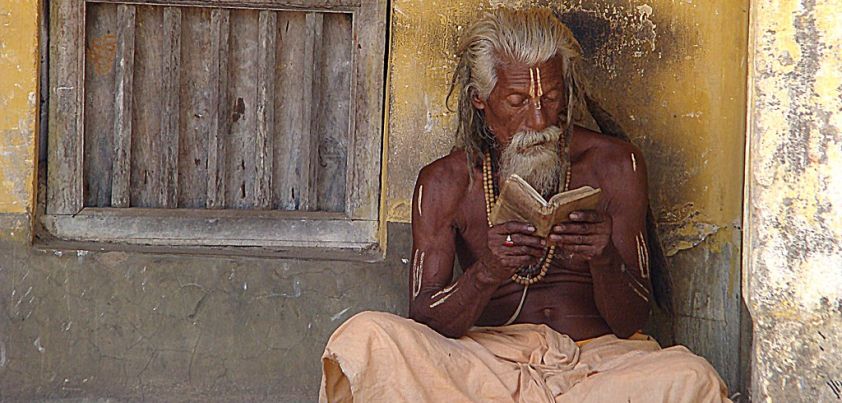 This story by R. K. Narayan, is based on the Tamil legend of Kannagi, a devoted wife who stands by her husband despite his love affair with a dancer. When he finally repents after squandering their fortune on entertainment and gifts for the other woman, they move to another city. They live happily there until Kannagi’s husband is framed for theft and summarily executed while trying to sell one of her gold anklets. Kannagi’s wrath is so great that she calls on the gods and has the city destroyed. Later, she learns that her fate was the result of karma. More…
This story by R. K. Narayan, is based on the Tamil legend of Kannagi, a devoted wife who stands by her husband despite his love affair with a dancer. When he finally repents after squandering their fortune on entertainment and gifts for the other woman, they move to another city. They live happily there until Kannagi’s husband is framed for theft and summarily executed while trying to sell one of her gold anklets. Kannagi’s wrath is so great that she calls on the gods and has the city destroyed. Later, she learns that her fate was the result of karma. More…
Archives
Like the Sun
 The major theme of this story by R. K. Narayan is the nature and consequences of truth. After observing that relationships involve tempering truth so as not to hurt one another, the protagonist adds that life is not worth living without telling nothing but the truth at least one day each year. On one of these days, his honesty upsets three people. The first two are needlessly hurt; the third, although unhappy, benefits from his frankness. The story shows that truth is indeed like the sun: most of the time warm and nourishing, but also capable of causing serious damage. More…
The major theme of this story by R. K. Narayan is the nature and consequences of truth. After observing that relationships involve tempering truth so as not to hurt one another, the protagonist adds that life is not worth living without telling nothing but the truth at least one day each year. On one of these days, his honesty upsets three people. The first two are needlessly hurt; the third, although unhappy, benefits from his frankness. The story shows that truth is indeed like the sun: most of the time warm and nourishing, but also capable of causing serious damage. More…
The Doctor’s Word
 In this story by R. K. Narayan, a doctor renowned for telling patients the truth, even if the news is bad, faces a dilemma. A seriously ill close friend asks for a prognosis, saying that if he is dying he must finalize his will to protect his wife and children. The doctor doesn’t think he will survive the night, and is concerned that the shock of hearing this will kill him. He must choose between telling the truth, or lying to give is friend hope and a small chance of survival. Themes include truthfulness, friendship, faith, hope, choices and consequences. More…
In this story by R. K. Narayan, a doctor renowned for telling patients the truth, even if the news is bad, faces a dilemma. A seriously ill close friend asks for a prognosis, saying that if he is dying he must finalize his will to protect his wife and children. The doctor doesn’t think he will survive the night, and is concerned that the shock of hearing this will kill him. He must choose between telling the truth, or lying to give is friend hope and a small chance of survival. Themes include truthfulness, friendship, faith, hope, choices and consequences. More…
A Horse and Two Goats
 This story from R. K. Narayan is a humorous account of the protagonist (Muri)’s trials and tribulations in a remote Indian village. Its major theme is culture clash (the villagers’ deep spirituality and acceptance of their lot vs. an American’s “money is everything” attitude). Other themes include miscommunication (and how it can sometimes pay off handsomely), change (younger villagers’ loss of appreciation of their cultural heritage, as symbolized by their indifference towards the statue), chauvinism (both men are extremely patronizing towards their wives), and archaeological looting (the American must surely recognize that the statue is of spiritual and/or historical significance!). More…
This story from R. K. Narayan is a humorous account of the protagonist (Muri)’s trials and tribulations in a remote Indian village. Its major theme is culture clash (the villagers’ deep spirituality and acceptance of their lot vs. an American’s “money is everything” attitude). Other themes include miscommunication (and how it can sometimes pay off handsomely), change (younger villagers’ loss of appreciation of their cultural heritage, as symbolized by their indifference towards the statue), chauvinism (both men are extremely patronizing towards their wives), and archaeological looting (the American must surely recognize that the statue is of spiritual and/or historical significance!). More…
Naga
 In this story by R. K. Narayan, a widowed Indian snake charmer trains a monkey for his young son so the two can work together entertaining people in the streets. All goes well until the father runs away with a strumpet in a blue sari, taking the monkey with him. Left alone with the snake, which has grown too old to perform, the boy misses the monkey more than his father. He reluctantly keeps the snake after realizing it can’t survive in the wild, and looks for another kind of work. Themes include poverty, selfishness, abandonment, independence, loyalty, compassion. More…
In this story by R. K. Narayan, a widowed Indian snake charmer trains a monkey for his young son so the two can work together entertaining people in the streets. All goes well until the father runs away with a strumpet in a blue sari, taking the monkey with him. Left alone with the snake, which has grown too old to perform, the boy misses the monkey more than his father. He reluctantly keeps the snake after realizing it can’t survive in the wild, and looks for another kind of work. Themes include poverty, selfishness, abandonment, independence, loyalty, compassion. More…
The House Opposite
 In this story by R. K. Narayan, an Indian “hermit” is both offended and titillated by the activities of a prostitute living opposite. His initial reaction is to label her a “monstrous” devil. However, imagining what she does night after night excites him to the point of obsession. There is a double irony here. The hermit, who has supposedly given up all pleasures, is consumed by desire. The prostitute, who regards him as a saint, respectfully seeks his blessing. It is not until this request that the hermit recognizes the woman’s humanity. Themes include spirituality, desire, self-righteousness, judging others, humanity. More…
In this story by R. K. Narayan, an Indian “hermit” is both offended and titillated by the activities of a prostitute living opposite. His initial reaction is to label her a “monstrous” devil. However, imagining what she does night after night excites him to the point of obsession. There is a double irony here. The hermit, who has supposedly given up all pleasures, is consumed by desire. The prostitute, who regards him as a saint, respectfully seeks his blessing. It is not until this request that the hermit recognizes the woman’s humanity. Themes include spirituality, desire, self-righteousness, judging others, humanity. More…
An Astrologer’s Day
 The “astrologer” in this story by R. K. Narayan is a fake, making a living by knowing enough about human nature to trick people into believing he has mystical powers. One day, he bargains with a reluctant passer-by to answer a question for many times his usual fee. He tries to cancel the reading immediately the passer-by sits down, but the man forcibly insists he continues. Although a deliberate lie, his answer not only eases the tormented man’s mind, but also brings in peace and redemption to himself. Themes include deception, fate, crime and punishment, revenge, redemption, spirituality, greed. More…
The “astrologer” in this story by R. K. Narayan is a fake, making a living by knowing enough about human nature to trick people into believing he has mystical powers. One day, he bargains with a reluctant passer-by to answer a question for many times his usual fee. He tries to cancel the reading immediately the passer-by sits down, but the man forcibly insists he continues. Although a deliberate lie, his answer not only eases the tormented man’s mind, but also brings in peace and redemption to himself. Themes include deception, fate, crime and punishment, revenge, redemption, spirituality, greed. More…
Under the Banyan Tree
 This story by R. K. Narayan starts by contrasting the village of Somal’s poor utilities and sanitation practices with the almost idyllic existence of its inhabitants. Set before the coming of electronic media, the only regular source of entertainment is Nambi, the village storyteller. As de-facto village priest, Nambi is also the focal point of its culture and traditions. Sadly, he is getting old. He forgets prepared stories, and has difficulty coming up with new material. Fortunately, he has the good sense to make his ‘greatest’ story his last. Themes include storytelling, community, aging, knowing when to stop, spirituality.. More…
This story by R. K. Narayan starts by contrasting the village of Somal’s poor utilities and sanitation practices with the almost idyllic existence of its inhabitants. Set before the coming of electronic media, the only regular source of entertainment is Nambi, the village storyteller. As de-facto village priest, Nambi is also the focal point of its culture and traditions. Sadly, he is getting old. He forgets prepared stories, and has difficulty coming up with new material. Fortunately, he has the good sense to make his ‘greatest’ story his last. Themes include storytelling, community, aging, knowing when to stop, spirituality.. More…
Forty-Five a Month
 In this 1940s story by R. K. Narayan, a working-class father is tortured by guilt over his inability to spend time with his young daughter and provide some of the luxuries other children enjoy. When the chronically overworked man asks for an evening off to take her to a movie, he is refused. He is on the point of resignation when offered a small raise that the family needs badly. In a poignant moment, he arrives home late and finds his daughter asleep, still dressed for the movie. Themes: childhood innocence, parent-child relationships, powerlessness, exploitation, financial struggle, sacrifice, guilt. More…
In this 1940s story by R. K. Narayan, a working-class father is tortured by guilt over his inability to spend time with his young daughter and provide some of the luxuries other children enjoy. When the chronically overworked man asks for an evening off to take her to a movie, he is refused. He is on the point of resignation when offered a small raise that the family needs badly. In a poignant moment, he arrives home late and finds his daughter asleep, still dressed for the movie. Themes: childhood innocence, parent-child relationships, powerlessness, exploitation, financial struggle, sacrifice, guilt. More…